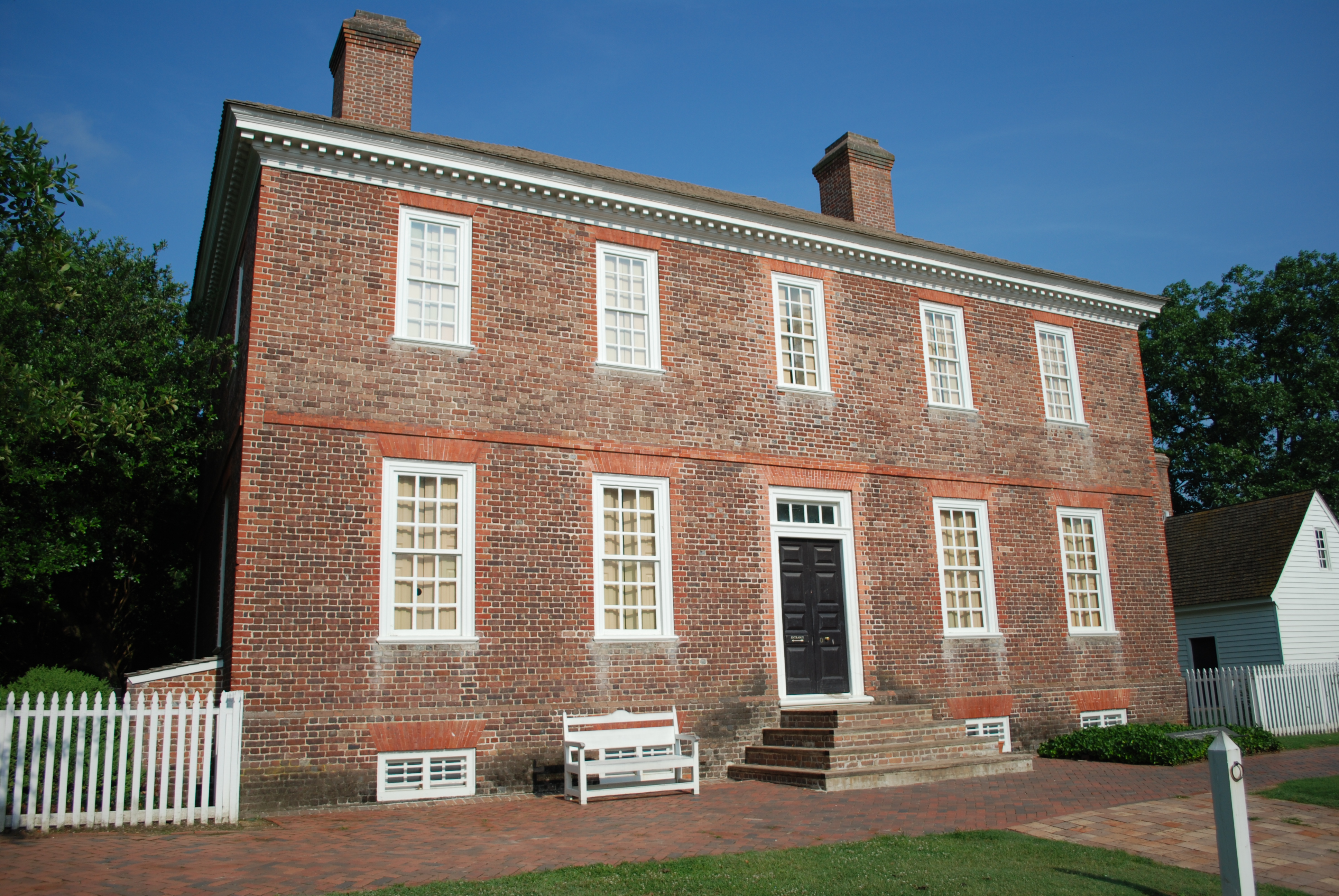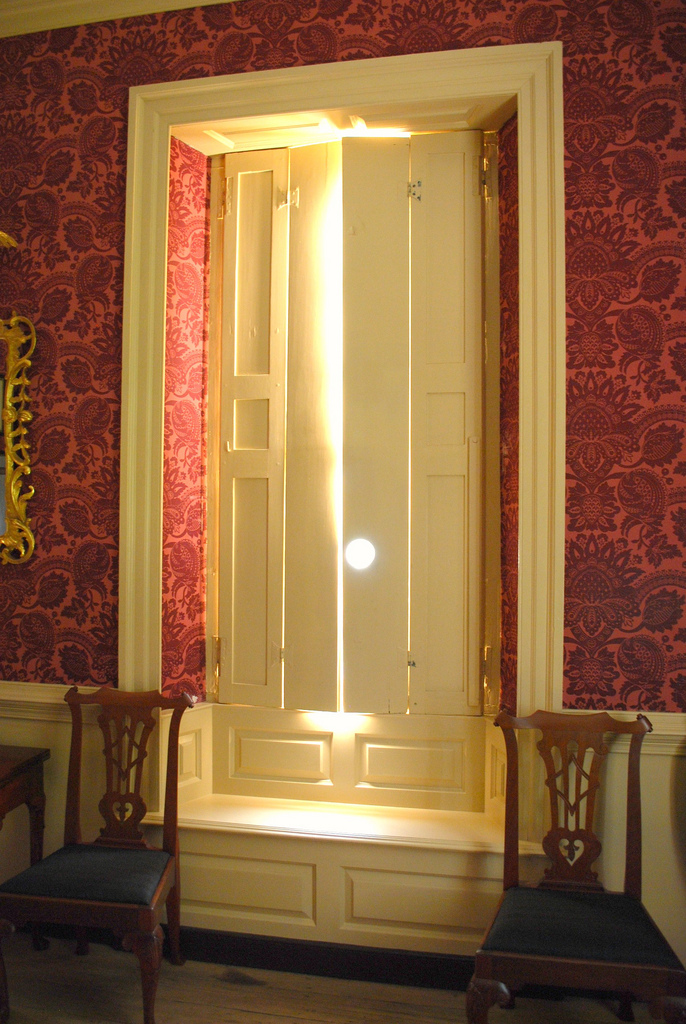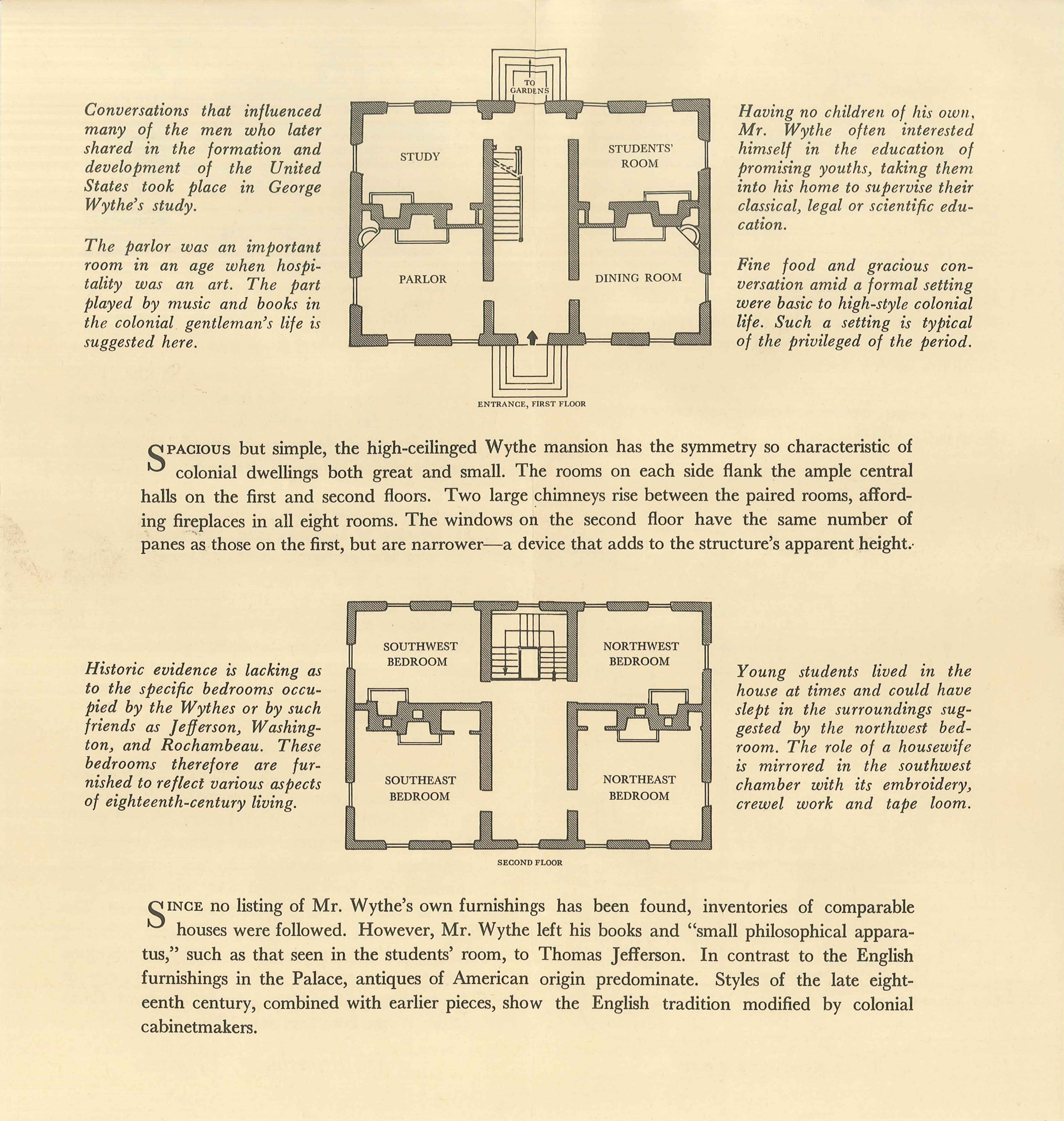Difference between revisions of "George Wythe House"
m |
m |
||
| Line 3: | Line 3: | ||
==History== | ==History== | ||
| − | The Wythe House once belonged to George Wythe's father-in-law, [[wikipedia:Richard Taliaferro|Richard Taliaferro]], of [[wikipedia:Powhatan (Five Forks, Virginia)|Powhatan plantation]] in James City County. The house was constructed between 1752 to 1754 and was conceived as a whole with no additions made to the rectangular two story structure. The house was built during a period of time when the Governor's Palace (Williamsburg, Virginia) was being renovated. | + | The Wythe House once belonged to George Wythe's father-in-law, [[wikipedia:Richard Taliaferro|Richard Taliaferro]], of [[wikipedia:Powhatan (Five Forks, Virginia)|Powhatan plantation]] in James City County. The house in WIlliamsburg was constructed between 1752 to 1754 and was conceived as a whole with no additions made to the rectangular two story structure. The house was built during a period of time when the Governor's Palace (Williamsburg, Virginia) was being renovated. |
When Taliaferro's daughter, Elizabeth, married George Wythe in 1755, the couple received the house as a wedding present, with a life tenancy at Elizabeth's father's death in 1779. Elizabeth lived here until her death in 1787, and George moved to Richmond, Virginia in 1791 to serve as a judge. | When Taliaferro's daughter, Elizabeth, married George Wythe in 1755, the couple received the house as a wedding present, with a life tenancy at Elizabeth's father's death in 1779. Elizabeth lived here until her death in 1787, and George moved to Richmond, Virginia in 1791 to serve as a judge. | ||
Latest revision as of 11:20, 25 August 2023

The Wythe House was the Williamsburg, Virginia home of George Wythe, signer of the United States Declaration of Independence and father of American jurisprudence. It is located in what is now Colonial Williamsburg, on Palace Green, adjacent to Bruton Parish Church. The property was declared a National Historic Landmark on April 15, 1970.
Contents
History
The Wythe House once belonged to George Wythe's father-in-law, Richard Taliaferro, of Powhatan plantation in James City County. The house in WIlliamsburg was constructed between 1752 to 1754 and was conceived as a whole with no additions made to the rectangular two story structure. The house was built during a period of time when the Governor's Palace (Williamsburg, Virginia) was being renovated.
When Taliaferro's daughter, Elizabeth, married George Wythe in 1755, the couple received the house as a wedding present, with a life tenancy at Elizabeth's father's death in 1779. Elizabeth lived here until her death in 1787, and George moved to Richmond, Virginia in 1791 to serve as a judge.
The house served as headquarters for General George Washington; September 14th to 17th, and 22nd to 28th, 1781 prior to the Siege of Yorktown.[1]
The house saw several subsequent owners. In 1926 the Reverend Dr. W.A.R. Goodwin, Rector of adjoining Bruton Parish Church, established his offices on the second floor after the Parish acquired the building for church use. Dr. Goodwin is known as the "Father of Colonial Williamsburg." Colonial Williamburg officially obtained the property in 1938, and in 1939 the interior was restored to the form and appearance the Wythe family would have known.
Exterior
The House

The facade is constructed of red brick with white woodwork and is perfectly symmetrical, with the first floor having two windows on each side of the door, and five windows in alignment with the bottom windows on the second floor. The hip roof has brick chimneys rising from the side slopes of the roof. The roof is supported by a modillion cornice.
The lighter-colored bricks framing the windows and doors are called "rubbed bricks," as the masons would rub one side of the bricks against each other until a rosy color became evident. The house has a beveled water table and the walls are laid in Flemish bond. The entrance is reached by a small flight of steps with a large door with raised panels and a transom window.
The Property
The property has fine conjectural gardens and several outbuildings including a smokehouse, external kitchen, laundry, poultry house, lumber house, well, dovecote, and a stable.[3] The gardens consist of brick paths and hedges with several small shrubs dotting the landscape. The property is contained by a simple white fence with hedges trimming the edges of the gardens.
Interior

The house is a standard center-passage, double-pile plan. A staircase rises on the left side of the passage. The hall contains four doors leading to the rooms.
The room interpreted as a parlor by Colonial Williamsburg is to the left before the staircase. A bowfat, a china cupboard, is built into the corner to the left of the fireplace.
The dining room is across from the parlor, which it mirrors. A fireplace and bowfat are in the inside wall. Wainscot lines this room; there is a crown molding.
A bedroom is located behind the dining room, with a door connecting the two rooms. A white chair rail divides the walls with a black base board. The floors are pine. The bedroom has a doorway leading into the main hall to the rear of the house.
The room interpreted as Wythe's office or study is located behind the parlor. The room contains a fireplace with a blue mantel and plastered firebox. The floors are pine.
The second floor is similar in layout to the first. A central hall runs the length of the house with four bedrooms in the corners of the house. Each of these rooms has a fireplace. The windows on this upper floor are actually slightly smaller than the first floor windows but contain the same amount of panels (18) and a double sash.
See also
References
- ↑ http://www.history.org/visit/tourTheTown/flash.cfm
- ↑ An example of a solar opaque (or "opake") microscope may be found on Plate 5 in George Adams' Essays on the Microscope: Containing a Practical Description of the Most Improved Microscopes (London: Robert Highmarsh, 1787), following p. 724.
- ↑ http://www.history.org/Almanack/places/hb/hbwythe.cfm#viewMedia
Exterior links
- Wolf Law Library Flickr album.
- "George Wythe house," Colonial Williamsburg.
- "The George Wythe House: Its Furniture and Furnishings," Colonial Williamsburg Digital Library.